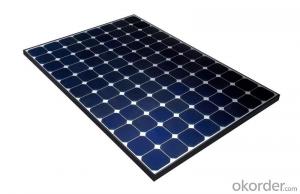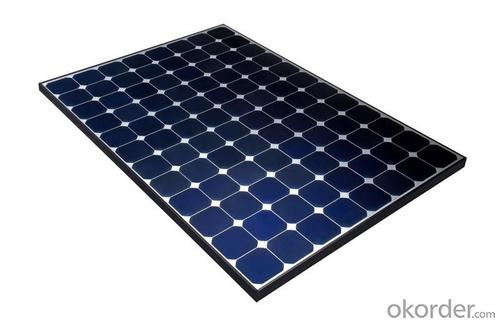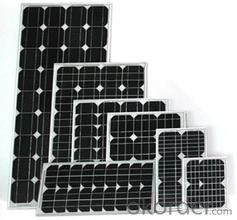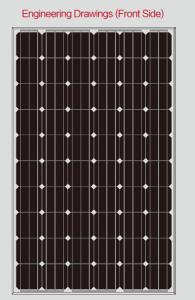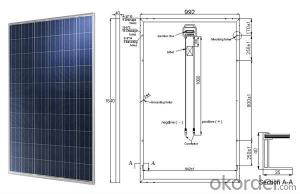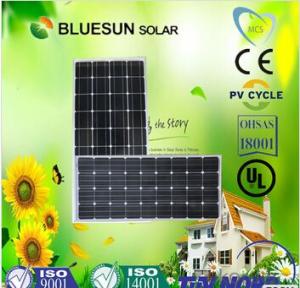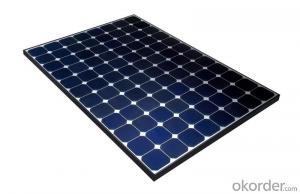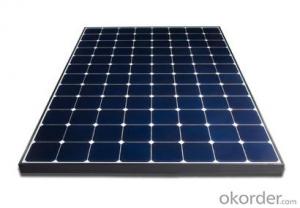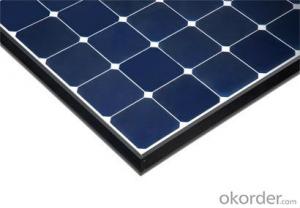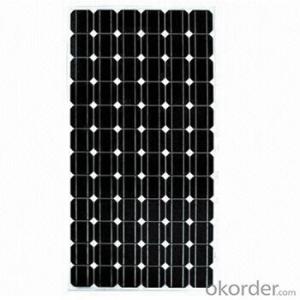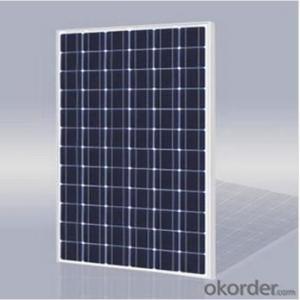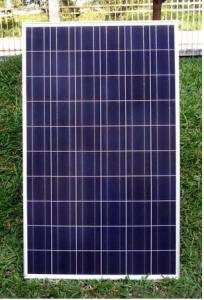Solar Panels in Field:Multicrystalline Solar Panel 185w A Grade for Commercial
- Loading Port:
- Shanghai
- Payment Terms:
- TT OR LC
- Min Order Qty:
- 100 watt
- Supply Capability:
- 20000 watt/month
OKorder Service Pledge
OKorder Financial Service
You Might Also Like
Specification
Muticrystalline Solar Panel 175W A Grade For Commercial
Introduction
It is a form of photoelectric cell, defined as a device whose electrical characteristics, such as current, voltage, or resistance, vary when exposed to light. Solar cells are the building blocks of photovoltaic modules, otherwise known as solar panels.
Connecting cells in parallel yields a higher current; however, problems such as shadow effects can shut down the weaker (less illuminated) parallel string (a number of series connected cells) causing substantial power loss and possible damage because of the reverse bias applied to the shadowed cells by their illuminated partners. Strings of series cells are usually handled independently and not connected in parallel, though as of 2014, individual power boxes are often supplied for each module, and are connected in parallel. Although modules can be interconnected to create an array with the desired peak DC voltage and loading current capacity, using independent MPPTs (maximum power point trackers) is preferable. Otherwise, shunt diodes can reduce shadowing power loss in arrays with series/parallel connected cells.[citation needed]
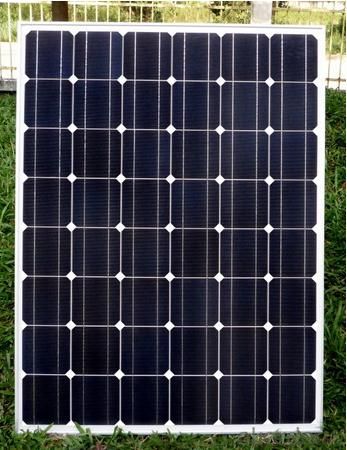
Suggested application
Home lighting business lighting,
Garden lighting, pavement lighting
Farmer household lighting
Product feature
modules are made of Monocrystalline or Polycrystalline Silicon cell.
Materials and color of the solar panel frame: Clear anodized aluminum alloy type 6063T5 Universal frame; Silver-white color;
The output connection gathers the coupling: Selects conforms to the IEC-612615; 2005, class II, IEC61730 international standard; Airtight waterproofing binding clamp;
Module seal structure: The surface is thick, the high diaphanous rate armored glass with solar cell board special-purpose 3.2mm becomes after the high temperature lamination craft. The back selects has waterproof and anti- aged performance fine TPT materials. The entire block battery board has, the waterproofing, the anti- aging airtight and so on the fine performance;
Power tolerance: +/-3%
Packaging
International standard cartons(according to the requirements of customers )
- Q: Why might energy from the solar panels sometimes be near zero even in the summer?
- Hey Cosmic, forget about Wayfare and Jenny here, but I have to say your question is a bit vague. When you say the panels produce near zero, how near? Are you using a watt meter, ammeter, or some other sort of metering device. Solar electric, or photovoltiac panels are made almost entirely of silicone wafers. Same as computer chips, when they get hot, the resist the flow of electrons. This is why most panel manufacturers advise installers to upgauge wiring if the temperature falls below 40 degrees F (5C) regularly. Below 0 C, you have to upgauge 2 wire sizes. A good quality panel will put out 50% of its rated power in very cold climates, so it stands to reason that they will put out substantially less in hot weather. Many people think places like the SW United States is great for solar because it's always sunny. In Las Vegas for example, they have 27 sunny days a month, and in August, the temperature frequently reaches 50 degrees C (20F) so people with photovoltiac panels are not even getting half their rated power on a good day. I'm not sure this is what you are asking about. Our home has been powered by the wind and sun for 2 years now. In the summer in the upper midwest, the days are warmer of course, but also much longer than in the winter. So our batteries will frequently fill up by 2:00pm, and the charge controller will taper off the solar charging the rest of the day to minimize overcharging. If you were to check the meters at 3pm, you might notice only 3 or 4 amps coming in when the array is rated at 42. This is normal for us in July and August. These are some reason why a solar array produces near zero in the summertime. Take care Cosmic, Rudydoo
- Q: Can solar panels be installed on a metal roof?
- Yes, solar panels can be installed on a metal roof. In fact, metal roofs are often considered ideal for solar panel installation due to their durability and longevity. The metal roof provides a strong and stable surface for mounting the panels, and the sleek design of the panels can complement the aesthetics of the roof. Additionally, the metal roof's reflective surface can help enhance the overall efficiency of the solar panels by bouncing sunlight back onto them.
- Q: i check the diodes in the backside of solar panels it reads out to be 0.433 each give me the same result but i was amazed when i check out the last two one which on clamp meter screen give me ''0L'' what this means? is that diode have malfunctions??is this reasons that the output of solar has been decreased?
- First of all, make sure that you are taking readings in the dark (with the solar panel indoors and covered). 0.433 is a reasonable forward voltage for a Schottky diode. Ideally, it diode should read open one way (possibly OL for your meter), and 0.4 the other way. If it's reading OL both ways, the diode is bad. You can either unsolder it or cut it out and verify that it is bad.
- Q: I have a home in Manchester Tn and we have been slowly remodeling the home. It is about 200 sq ft of living space. Our normal electric bill is about 50 a month. We would like to add some solar panels to the home to help reduce the amount of the bill. How many panels do I need and what would be the cost? I am not trying to go completely of the grid but I would like to start somewhere and maybe over the years be able to add. What is your recommendation for a reasonable cost of under 2 to 3 k??
- Unless there has been some major breakthrough in solar panel efficiency - Forget it. I had looked at some utility interactive systems where the electricity generated by the solar panels went through a special inverter and into the electrical system of the house, any power you didn't use went backwards through the meter and into the grid. I figured that even if it was sunny every day, it would take about 20 years to break even on the system. That is, if I had invested $5,000 in a small system, to save $5,000 off the electric bill would take 20 years. If I had $5,000 to invest, this wouldnt be the place! It would take much more than 20 years of electrical savings to match even a modest investment. Then, don't forget what happens if 0 years from now the inverter or some of the panels fail and need replaced. Invest in fluorescent lights, maybe even LEDs. You will see a much quicker return on investment. Install more insulation, put in a heat-pump system. I appreciate you desire to save some energy, solar just isn't going to be worth doing, at least not yet.
- Q: Can someone explain to me how solar panels can be used as modern architectural attributes? please help
- They aren't considered attributes - electrical solar panels are expanses of gray and aluminum covered with glass and water heating panels are expanses of black covered with glass. To cover the cost of investment they must be mounted at the best angle for the location and climate throughout the year and therefore may dictate the form of the roof (if sloped as on residences) or may not be visible in an architectural sense (if positioned on a flat roof of a commercial building.) No matter where placed, provision has to be made for safely accessing them for repair and maintenance.
- Q: Are there any safety concerns with solar panels?
- There are a few safety concerns associated with solar panels, but they are relatively minimal and manageable. The main concerns include the risk of electrical shock during installation or maintenance if proper precautions aren't followed, fire hazards due to faulty wiring or improper installation, and potential damage from extreme weather conditions. However, with proper installation, regular maintenance, and adherence to safety guidelines, these risks can be significantly mitigated, ensuring the safe use of solar panels.
- Q: Where can I find the info (sites) that clearly gives the anatomy of a solar panel?Likewise, I want to know where can I find (sites) the solar panel that produces 3.75 v? Thank you very much!!!
- You've probably seen calculators that have solar cells -- calculators that never need batteries, and in some cases don't even have an off button. As long as you have enough light, they seem to work forever. You may have seen larger solar panels -- on emergency road signs or call boxes, on buoys, even in parking lots to power lights. Although these larger panels aren't as common as solar powered calculators, they're out there, and not that hard to spot if you know where to look. There are solar cell arrays on satellites, where they are used to power the electrical systems. You have probably also been hearing about the solar revolution for the last 20 years -- the idea that one day we will all use free electricity from the sun. This is a seductive promise: On a bright, sunny day, the sun shines approximately ,000 watts of energy per square meter of the planet's surface, and if we could collect all of that energy we could easily power our homes and offices for free.
- Q: Can solar panels be used for heating a greenhouse?
- Yes, solar panels can be used for heating a greenhouse. Solar panels can be used to generate electricity, which can then be used to power heating systems in a greenhouse. This can help maintain a consistent and optimal temperature for plant growth. Additionally, solar panels can also be used to heat water, which can be circulated through a greenhouse to provide warmth.
- Q: Can solar panels be used to power a camping trip?
- Yes, solar panels can be used to power a camping trip. They are an excellent source of clean and renewable energy, allowing campers to charge their electronic devices, power lights, refrigerators, and other camping equipment. Solar panels are portable and can be easily set up in a sunny location to harness the sun's energy during the day and store it in batteries for use at night. They provide a sustainable and eco-friendly solution for powering camping adventures.
- Q: Can anyone give me some info on how to figure how many panels needed for a 0 volt 2 amp pool motor. Thanks/ Run 5 hours a day
- I don't think heating a 70,000 gallon pool with solar panels is practical. My husband has designed and built our solar hot water system. It works quite well. We live in Arizona. There's no way we could heat that much water using sun energy. You have to heat the water and compete with the outside air.
Send your message to us
Solar Panels in Field:Multicrystalline Solar Panel 185w A Grade for Commercial
- Loading Port:
- Shanghai
- Payment Terms:
- TT OR LC
- Min Order Qty:
- 100 watt
- Supply Capability:
- 20000 watt/month
OKorder Service Pledge
OKorder Financial Service
Similar products
Hot products
Hot Searches
